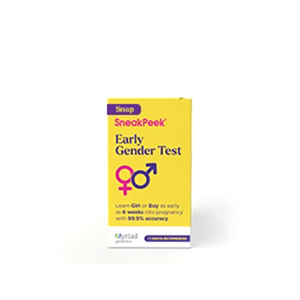Published on November 24th, 2020 and Updated on February 29th, 2024
Check out SneakPeek Gender Test to find out your baby’s gender as early as 6 weeks at over 99% accuracy1!
When your baby is born—and even before—you may be curious about the traits they’ll inherit. Will they have your signature curly hair or your dad’s straight hair, your brown eyes or your partner’s blue eyes? It all comes down to the different genes that are passed down from the parents. And while some genes may be inherited from the father, what about genes inherited from the mother?
How Human Genetics Work

Genetic inheritance is more complicated than mixing 50% of mom’s genes with 50% of dad’s. To learn which characteristics mothers are responsible for and why, it is first important to understand how genetic traits are inherited.
Polygenic Traits
Most human traits are polygenic, which means they’re determined by the combination of several genes from both parents. For example, there are at least 700 sequences in your genetic code that can affect height. Similarly, your skin, hair color, and eye color are based on a hodgepodge combination of genes—which explains why our eyes have such a wide spectrum of colors. So when asking “what color eyes will my baby have?” or “where does the hair gene come from?” the answer is a bit more complex than you might expect.
Uniparental Inheritance through Chromosomes
Certain genes, however, are transmitted exclusively from one parent to the offspring. To understand this one-sided genetic inheritance and, more specifically, maternal inheritance, let’s take a quick dive into the thrilling world of chromosomes.
Human cells contain chromosomes, the structures that hold our unique genetic information. Each cell has 23 unique chromosomes, responsible for different functions and different genetically inherited traits.
These chromosomes can be split into two categories:
- Autosomal – Most humans inherit 22 pairs of matching chromosomes, one from each parent. These pairs code for the same traits, and it’s the combination of these genes from both mom and dad that determine what features a child exhibits.
- Sex-linked –The genes contained within the 23rd pair of chromosomes are expressed as sex-linked traits. Since X and Y chromosome pairings determine a child’s gender, they can also help illuminate which traits came from mom versus dad.
Here’s how that breaks down by gender:
- Girls receive an X-chromosome from each parent, therefore their X-linked traits will be partially inherited from dad, too.
- Boys, on the other hand, only receive a Y chromosome from their father and an X chromosome from their mother. That means all of your son’s X-linked genes and traits will come straight from mom.
Since boys get their only X chromosome and those affiliated traits from mom, it’s easier to identify which of their sex-linked traits come from Mom and which come from Dad. Since girls have two X-chromosomes, it’s not entirely possible to know which sex-linked traits come from mom versus dad without analyzing the family’s genetic code.
Maternally-Inherited Traits
From mitochondrial DNA to X and Y chromosomes, the human genome is a mystery that scientists are still unraveling. But one thing’s for sure, some behaviors and traits have been linked to maternal influence—biological and otherwise.

#1 Moms Pass Down X-Linked Recessive Traits to Their Sons
Where fathers can pass down Y-linked traits to their sons, X-linked traits are determined by the genetic material on the X-chromosome, which only mothers contribute to their sons.
The Supporting Evidence: Because boys only have the one X-chromosome, all X-linked traits can be traced back to the maternal influence. X-linked disorders may include:
- Red-green color-blindness – being unable to distinguish between green and red—is a recessive X-linked trait. That means if mom has the recessive X-linked DNA, the trait will manifest in her son. This is why red-green color blindness in girls is particularly rare—both parents would have to have the recessive allele.
- Hemophilia A – This genetic condition causes blood to clot improperly. People who are diagnosed with hemophilia can bruise easily and may suffer from abnormally heavy bleeding from even small cuts. Like red-green color blindness, hemophilia A is an X-recessive trait.
The Bigger Picture: Sons can trace some characteristics right back to Mom, according to the genetic variants of x-linked traits.


#2 Signs of Aging
As you age, your face begins to show the signs-crow’s feet, forehead wrinkles, laugh lines. You might have your mother to thank for when and how these signs of aging materialize. Specifically, the mom’s mitochondria contributes to aging processes.
The Supporting Evidence: The mitochondria is a tiny—but powerful—part of a cell. It’s responsible for the cell’s respiration and energy production processes. And, mitochondrial DNA (or mDNA) is inherited strictly from the mom.
Unlike X-linked traits, both boys and girls receive their mitochondria and those corresponding genetic traits from mom. Because mDNA can only be inherited from the mother, the father’s mDNA essentially self-destructs when it meets and fuses with the mother’s cells.
The mitochondria has significant influence over the aging process, among other things. Our mitochondrial DNA sustains damage from:
- Free radicals from the sun’s UV rays
- Toxins like cigarette smoke
- Pollution
These factors mutate mitochondrial DNA and affect the way we age. But there’s more to it than just personal exposure and environmental factors.
According to researchers at Karolinka Institutet and the Max Planck Institute for Biology and Aging, your child – boy or girl – will inherit mom’s mDNA, including mitochondrial disease or dysfunction. Just ask Dr. Nils-Göran Larsson, professor at the Karolinska Institute and lead investigator at the Max Planck Institute for Biology of Aging. “Research showed that our mothers’ mitochondrial DNA seems to influence our own aging. If we inherit mitochondrial DNA with mutations from our mother, we age more quickly.”
Free radicals in the sun’s UV rays and other environmental factors can damage mitochondria – essentially mutating it. This mitochondrial mutation is what’s passed down to offspring. There’s even research to suggest that children of older parents inherit suboptimal mitochondria – meaning mitochondria that’s not at its healthiest – which stays with children as they age.
The Bigger Picture: While genetic information from the mitochondria does play a role in your child’s aging, there are other factors that can make a big difference in reducing cancer risk and maintaining long-term skin health. That includes wearing sunscreen, staying away from cigarettes, and eating a diet rich in antioxidants.

#3 Intelligence: X-Linked & Mitochondrial
While there is no single “intelligence gene,” one of the contributing factors for your child’s keen intellect comes from the mother’s DNA.
The Supporting Evidence: There is increasing research that demonstrates mom’s role in her children’s intelligence—aside from her role as the math tutor, spell-checker, and project helper.
- The brain is jam packed with mitochondrial DNA – The brain is a highly complex organ, probably more so than any other part of the body. Tissues that require more energy, including the brain, have higher densities of mitochondria. Again, this mitochondrial DNA comes exclusively from Mom, meaning those brainiac genes are largely hers.
- Intelligence is carried on the X chromosome – The X chromosome plays a significant role in developing the cerebral cortex, a region of the brain dedicated to social-cognitive functions. Because mom has two X chromosomes and dad only has one, more of the intellectual X chromosome genes are likely coming from a boy’s mother.
As for your daughter, she’ll have both Mom and Dad to thank for her brains because she gets an X from each parent—but maybe, thanks to Mom’s mitochondrial contribution, Mom gets a tiny bit more of the credit for her baby girl’s smarts.
The Bigger Picture: While mom’s genes can provide a leg up, intelligence is hugely dependent on a myriad of environmental factors, from family life to learning resources.

#4 Mental Health and Disorders
It’s not just physical and behavioral traits that are inherited, but mental and emotional characteristics are, too. While environmental circumstances play a part in the development of mood disorders, conditions, and diseases, they work in concurrence with genetic predispositions – not always from mom exclusively, but research suggests that it’s more common than we otherwise thought.
The Supporting Evidence: A study from 2016 found an association between depression in mothers and their daughters in an analysis of 35 families. Interestingly, they also found that depression is not as likely to be passed down from fathers to their daughters, or fathers to their sons. But whether this association is due to genetic, prenatal, or postnatal causes remains unknown.
Depression is not the only condition that can manifest through inheritance. Another study found similar correlations between mothers with low serotonin levels and the frequency of ADHD in their offspring. Serotonin is a key chemical that helps to regulate and stabilize our moods, among other processes. Interestingly, prior studies suggested that low serotonin is a result of a mutation that obstructs its transmission. But it’s only children that have mothers with this mutation that are nearly twice as likely to develop ADHD rather than their fathers.
The Bigger Picture: The causes of mental disorders are complex and still not fully understood. But, given scientific understandings of genetic inheritance, chemical imbalances, and family dynamics, mom’s mental state has a significant impact on the mental state of their children.

#5 Sleeping Style
Sleeping patterns, behaviors, and even disorders are far more likely to be passed down from mom rather than dad. This includes insomnia and sleep-wake cycles.
The Supporting Evidence: A study in Sleep Medicine suggests that children inherit their sleeping patterns from mom. The study showed a distinct correlation between maternal insomnia and several sleep metrics in the child, including:
- How long the child slept
- How much time was spent in each stage of sleep
- How quickly (or slowly) the child fell asleep
- What times the child woke up
The scientists have yet to discover if these traits are thanks to autosomal, mitochondrial, or sex-linked genetics, but it’s certainly the next step for this research.
The Bigger Picture: When it comes to sleep behaviors, a genetic link is only part of the equation. Factors like sleep environment, health, and a child’s stage of development all impact a child’s sleep behaviors.
Sleep Medicine says that traits inherited from the mother can influence a child’s susceptibility to sleep disorders and difficulties, but without a glimpse into the genetic code itself, it’s impossible to say how much is DNA and how much is external factors.

#6 Metabolism
Maintaining a healthy body weight has much more to do with a healthy lifestyle than it does with genetics, but that isn’t to say that mom’s genes don’t help with burning off excess energy.
The Supporting Evidence: Contrary to popular belief, fat is an essential source of energy to keep our bodies running. Brown fat, in particular, is responsible for regulating body temperature in cold environments and metabolizing energy. This is in contrast to white fat cells, which grow in size when provided with excess energy (calories).
Researchers have identified that brown adipose tissue can be targeted to combat obesity. Not only that, but they also discovered that mothers carry a gene that allows brown fat to combat white fat, which is attributed to paternal genes.
This means that brown fat cells from mom help boost their children’s metabolism, and are protective against obesity and other health complications related to adipose tissue.
The Bigger Picture: Everyone is born with both brown and white fat reserves to sustain energy. The development of brown fat cells are attributed to mom, and while the size and shape of our bodies are not rigidly inherited, they are related to parental genetics. Nonetheless, eating a healthy diet and maintaining an active lifestyle is what keeps brown fat cells using energy instead of white fat cells storing it.

#7 Height
If mom is tall, it doesn’t automatically mean their kids will be tall, too. But her genes certainly have a role to play when competing with dad’s.
The Supporting Evidence: There is no one “tall” gene. In fact, at least 700 genetic variations affect your child’s height. But scientists have gleaned that Dad is responsible for most of the growing thanks to a growth factor known as IGF protein.
IGF proteins are strongly expressed in paternal genes. Mom’s genes, on the other hand, havean IGF protein inhibitor called IGF2R. That means Mom’s genes try to cancel out Dad’s growth factor genes.
Scientists have tried to understand why Dad’s genes fuel growth and Mom’s try to inhibit growth. One theory claims it may have something to do with the evolutionary benefits of a tall (or not so tall) child for each parent.
- Dad’s evolutionary programming wants his children to grow up big and strong so that they can survive and populate the gene pool with his genes, thus fulfilling his biological imperative of passing on his DNA to future generations. Dad’s genes tell a baby—still in utero—to soak up all the extra nutrients possible for increased growth.
- Mom’s evolutionary programming wants to survive pregnancy and childbirth! Pregnancy can take a toll on women, especially when it comes to health and nutrition in the early age of human evolution. So Mom’s genes suppress the child’s growth in utero to help manage the baby’s use of her nutritional resources so they can both prosper.
The Bigger Picture: Dad’s IGF protein growth factor will encourage his kid to grow tall. Mom’s IGF2R protein inhibitor gene will try to cancel out some of those growth factors. But those are just two genes out of hundreds that go into determining your child’s height. Environmental factors are important too, and how similar or different mom and dad’s height – and other genetic material – are to each other.
Predicting your children’s future isn’t easy. But you may find more answers than you ever thought possible with SneakPeek.
Start with the SneakPeek At-Home Early Gender Blood Test—the only at-home fetal sex test that can tell you whether you’re having a little boy or a little girl as early as 6 weeks into pregnancy! That’s months before a traditional 20-week anatomy ultrasound can tell you (and why our test is trusted by over 1 million moms and top obstetricians). Plus, our SneakPeek Test results are clinically-proven over 99% accurate1.
With science-backed, privacy-protected results you can trust, there’s no reason not to choose SneakPeek. We can’t wait to celebrate with you.
This post has been reviewed for accuracy by the following medical professional:
Katie Smith is a seasoned Certified Nurse Midwife and a nurturing mother to six children, offering a unique blend of professional expertise and personal experience. She is the founder of Birth Your Way Midwifery and Women’s Wellness Center in Bay County, Florida. Katie's comprehensive approach to care is informed by her hands-on experience in motherhood and her passion for empowering women through their birthing journey. Her dedication extends beyond her center as she actively engages in community wellness and family health education.
Sources:
- NPR. Which Genes Make You Taller? A Whole Bunch Of Them, It Turns Out. https://www.npr.org/sections/health-shots/2017/02/01/512859830/which-genes-make-you-taller-a-whole-lot-it-turns-out
- Family Education. 8 Traits Babies Inherit From Their Mother. https://www.familyeducation.com/pregnancy/traits-babies-inherit-from-their-mother
- New York Times. Why Do We Inherit Mitochondrial DNA Only From Our Mothers? https://www.nytimes.com/2016/06/24/science/mitochondrial-dna-mothers.html
- The Conversation. Do you share more genes with your mother or father? https://theconversation.com/do-you-share-more-genes-with-your-mother-or-your-father-50076
- LibreTexts. Mendelian Inheritance. https://bio.libretexts.org/Bookshelves/Human_Biology/Book%3A_Human_Biology_(Wakim_and_Grewal)/08%3A_Inheritance/8.4%3A_Mendelian_Inheritance
- National Center for Biotechnology Information. Understanding Genetics: A District of Columbia Guide for Patients and Health Professionals. https://www.ncbi.nlm.nih.gov/books/NBK132145/
- Merck Manual. Genes and Chromosomes. https://www.merckmanuals.com/home/fundamentals/genetics/genes-and-chromosomes
- NBC News. Are you destined to inherit your mother’s body? http://www.nbcnews.com/id/35254750/ns/health-womens_health/t/destined-inherit-your-moms-body/#.X2qaVJNKiL4
- National Center for Biotechnology Information. Body mass index associations between mother and offspring from birth to age 18: the Fels Longitudinal Study. https://www.ncbi.nlm.nih.gov/pmc/articles/PMC5478810/
- Sleep Medicine. The association of mothers’ and fathers’ insomnia symptoms with school-aged children’s sleep assessed by parent report and in-home sleep-electroencephalography. https://www.sciencedirect.com/science/article/pii/S1389945717303039
- The John Hopkins Newsletter. Children and mothers share sleep patterns. https://www.jhunewsletter.com/article/2017/09/children-and-mothers-share-sleep-patterns
- University Hospitals Case Medical Center. Mother’s genes can impact aging process. https://www.sciencedaily.com/releases/2013/08/130821132710.htm
- Facts, Views & Vision: Issues in Obstetrics, Gynaecology and Reproductive Health. Can we define maternal age as a genetic disease? https://www.ncbi.nlm.nih.gov/pmc/articles/PMC4086015/
- Independent. Children inherit their intelligence from their mother not their father, say scientists. https://www.independent.co.uk/news/science/children-intelligence-iq-mother-inherit-inheritance-genetics-genes-a7345596.html
- Karger. Insulin-Like Growth Factor 2 in Development and Disease: A Mini-Review. https://www.karger.com/Article/Fulltext/343995
- Children’s Hospital of Philadelphia. X-linked Recessive: Red-Green Color Blindness, Hemophilia A. https://www.chop.edu/conditions-diseases/x-linked-recessive-red-green-color-blindness-hemophilia
- Cleveland Clinic, Mitochondrial Diseases.
https://my.clevelandclinic.org/health/diseases/15612-mitochondrial-diseases - Scientific American, Like Mother, Like Daughter–the Science Says So, Too. https://www.scientificamerican.com/article/like-mother-like-daughter-the-science-says-so-too/
- University of Reading, Female-specific intergenerational transmission patterns of the human corticolimbic circuitry. https://centaur.reading.ac.uk/49005/3/Yamagata%20et%20al_inpress_JN.pdf
- Science Daily, ADHD more common in offspring of mothers with genetic serotonin deficiencies. https://www.sciencedaily.com/releases/2010/10/101004162940.htm
- Science Daily, Obesity: We inherit the dangerous fat from Dad — and the good fat from Mom. https://www.sciencedaily.com/releases/2018/09/180906100438.htm

Shop Our Products
SneakPeek aims to provide the most accurate and up-to-date information to help our readers make informed decisions regarding their health before, during, and after pregnancy. This article was written based upon trusted scientific research studies and/or articles. Credible information sources for this article are cited and hyperlinked.






